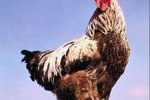The Brood Patch
The male and female penguin first bond to each other, and then they mate. The female lays one egg the size of a softball. The male pushes the egg up onto his own feet, where it is cushioned and protected by the male's "brood patch," a warm fold of feathers and fat that rest atop the feet. The egg remains in that location for nine straight weeks until it hatches during the coldest months of the Antarctic winter.
The Male Hatches the Egg
The males lose up to half their body weight during the nine weeks because they don't eat until after the egg hatches. If the male penguin loses too much weight, he will leave the egg and go back to the sea to hunt and eat. The abandoned chicks will not survive, so the survival of the species depends on the male birds being fat and healthy prior to the breeding season. The males with eggs will huddle together to keep warm, constantly moving around so that all the birds can get warm.
The New Chick
The male does more than just incubate the egg; with glands in his throat, he also secretes a nutritious liquid, which is then fed to the new chick. The chick will stay with the male to keep warm by lying on his feet the same way the egg was incubated until the chick grows its own down feathers. Soon, the female comes and assumes care over the chick for the next several weeks while the male feeds. She regurgitates food for the chick until the male returns, at which point they both take responsibility in raising the chick for several months.





